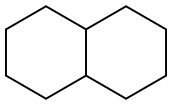General Description
A clear colorless liquid with an aromatic odor. Flash point 134°F. Less dense than water and insoluble in water. Vapors heavier than air.
Reactivity Profile
Saturated aliphatic hydrocarbons, such as DECAHYDRONAPHTHALENE(91-17-8), may be incompatible with strong oxidizing agents like nitric acid. Charring of the hydrocarbon may occur followed by ignition of unreacted hydrocarbon and other nearby combustibles. In other settings, aliphatic saturated hydrocarbons are mostly unreactive. They are not affected by aqueous solutions of acids, alkalis, most oxidizing agents, and most reducing agents. Oxidizes readily in air to form unstable peroxides that may explode spontaneously [Bretherick, 1979 p.151-154].
Air & Water Reactions
Flammable. Insoluble in water.
Health Hazard
Inhalation or ingestion irritates nose and throat, causes numbness, headache, vomiting; urine may become blue. Irritates eyes. Liquid de-fats skin and causes cracking and secondary infection; eczema may develop.
Fire Hazard
HIGHLY FLAMMABLE: Will be easily ignited by heat, sparks or flames. Vapors may form explosive mixtures with air. Vapors may travel to source of ignition and flash back. Most vapors are heavier than air. They will spread along ground and collect in low or confined areas (sewers, basements, tanks). Vapor explosion hazard indoors, outdoors or in sewers. Runoff to sewer may create fire or explosion hazard. Containers may explode when heated. Many liquids are lighter than water.
Chemical Properties
colourless liquid
Physical properties
Clear, colorless, flammable liquid with a mild methanol or hydrocarbon-like odor
Uses
Solvent for naphthalene, fats, resins,
oils; alternate for turpentine in lacquers, shoe
polishes, and waxes; component in motor fuels
and lubricants
Uses
Solvent for naphthalene, waxes, fats, oils, resins, rubbers; motor fuel and lubricants;
cleaning machinery; substitute for turpentine; shoe-creams; stain remover.
Definition
ChEBI: An ortho-fused bicyclic hydrocarbon that is the decahydro- derivative of naphthalene.
Production Methods
Decalin occurs naturally in crude oil and is produced commercially
by the catalytic hydrogenation of naphthalene. It is also a
product of combustion and is released from natural fires.
Chemical Reactivity
Reactivity with Water No reaction; Reactivity with Common Materials: No reaction; Stability During Transport: Stable; Neutralizing Agents for Acids and Caustics: Not pertinent; Polymerization: Not pertinent; Inhibitor of Polymerization: Not pertinent.
Environmental Fate
Photolytic. The following rate constants were reported for the reaction of decahydronaphthalene
and OH radicals in the atmosphere: 1.96 x 10-11 and 2.02 x 10-11 cm3/molecule?sec at 299 K for cis
and trans isomers, respectively (Atkinson, 1985). A photooxidation reaction rate constant of 2.00
x 10-11 was reported for the reaction of decahydronaphthalene (mixed isomers) and OH radicals in
the atmosphere at 298 K (Atkinson, 1990).
Chemical/Physical. Decahydronaphthalene will not hydrolyze because it has no hydrolyzable
functional group.
Purification Methods
Then the organic phase is separated, washed with water, saturated aqueous Na2CO3, again with water, dried with CaSO4 or CaH2 (and perhaps dried further with Na), filtered and distilled under reduced pressure (b 63-70o/10mm). It has also been purified by repeated passage through long columns of silica gel previously activated at 200-250o, followed by distillation from LiAlH4 and storage under N2. Type 4A molecular sieves can be used as a drying agent. Storage over silica gel removes water and other polar substances. [For the separation of cis and trans isomers see Seyer & Walker J Am Chem Soc 60 2125 1938, and Baker & Schuetz J Am Chem Soc 69 1250 1949.]
